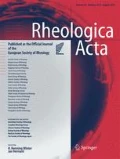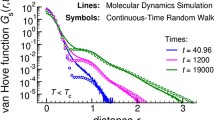Abstract
There are several models for the determination of molecular weight distributions (MWDs) of linear, entangled, polymer melts via rheometry. Typically, however, models require a priori knowledge of the critical molecular weight, the plateau modulus, and parameters relating relaxation time and molecular weight (e.g., k and α in τ=kMα). Also, in an effort to obtain the most general MWD or to describe certain polymer relaxation mechanisms, models often rely on the inversion of integral equations via regularization. Here, the inversion of integral equations is avoided by using a simple double-reptation model and assuming that the MWD can be described by an analytic function. Moreover, by taking advantage of dimensionless variables and explicit analytic relations, we have developed an unambiguous and virtually parameter-free methodology for the determination of MWDs via rheometry. Unimodal MWDs have been determined using only a priori knowledge of the exponent α and dynamic moduli data. In addition, the uncertainty in rheological MWD determinations has been quantified, and it is shown that the reliability of the predictions is greater for the high-molecular-weight portion of the distribution.






Similar content being viewed by others
References
Bersted BH, Slee JD (1977) A relationship between steady-state shear melt viscosity and molecular weight distribution in polystyrene. J Appl Polym Sci 21:2631–2644
Carrot C, Guillet J (1997) From dynamic moduli to molecular weight distribution: a study of various polydisperse linear polymers. J Rheol 41:1203–1220
Cocchini F, Nobile MR (2003) Constrained inversion of rheological data to molecular weight distribution for polymer melts. Rheol Acta 42:232–242
des Cloizeaux J (1988) Double reptation vs simple reptation in polymer melts. Europhys Lett 5:437–442
Ferry JD (1980) Viscoelastic properties of polymers, 3rd edn. Wiley, USA
Fetters LJ, Lohse DJ, Richter D, Witten TA, Zirkel A (1994) Connection between polymer molecular weight, density, chain dimensions, and melt viscoelastic properties. Macromolecules 27:4639–4647
Guzmán JD (2003) From synthesis to processing: links between polymerization mechanism, molecular weight distribution, rheological behavior, and extrusion. PhD Thesis, Illinois Institute of Technology
Jordan TC, Richards WD (2000) In: Legrand DG, Bendler JT (eds) Handbook of polycarbonate science and technology, Chapter 9. Dekker, New York
Léonardi F, Majesté J-C, Allal A, Marin G (2000) Rheological models based on the double reptation mixing rule: the effects of a polydisperse environment. J Rheol 44:675–692
Léonardi F, Allal A, Marin G (2002) Molecular weight distribution from viscoelastic data: the importance of tube renewal and Rouse modes. J Rheol 46:209–224
Llorens J, Rudé E, Marcos RM (2003) Polydispersity index from linear viscoelastic data: unimodal and bimodal linear polymer melts. Polymer 44:1741–1750
Maier D, Eckstein A, Friedrich C, Honerkamp J (1998) Evaluation of models combining rheological data with the molecular weight distribution. J Rheol 42:1153–1173
Malkin A, Teishev AE (1991) Flow curve-molecular weight distribution: is the solution of the inverse problem possible? Polym Eng Sci 31:1590–1596
Mead DW (1994a) Determination of molecular weight distributions of linear flexible polymers from linear viscoelastic material functions. J Rheol 38:1797–1827
Mead DW (1994b) Numerical interconversion of linear viscoelastic material functions. J Rheol 38:1769–1795
Nobile MR, Cocchini F (2000) Predictions of linear viscoelastic properties for polydisperse entangled polymers. Rheol Acta 39:152–162
Nobile MR, Cocchini F (2001) Evaluation of molecular weight distribution from dynamic moduli. Rheol Acta 40:111–119
Nobile MR, Cocchini F, Lawler JV (1996) On the stability of molecular weight distributions as computed from the flow curves of polymer melts. J Rheol 40:363–382
Press WH, Teukolsky SA, Vetterling WT, Flannery BP (1992) Numerical recipes in Fortran: The art of scientific computing, 2nd edn. Cambridge University Press, USA
Roths T, Maier D, Friedrich C, Marth M, Honerkamp J (2000) Determination of the relaxation time spectrum from dynamic moduli using an edge preserving regularization method. Rheol Acta 39:163–173
van Ruymbeke E, Keunings R, Bailly C (2002b) Determination of the molecular weight distribution of entangled linear polymers from linear viscoelasticity data. J Non Newtonian Fluid Mech 105:153–175
van Ruymbeke E, Keunings R, Stéphenne V, Hagenaars A, Bailly C (2002a) Evaluation of reptation models for predicting the linear viscoelastic properties of entangled linear polymers. Macromolecules 35:2689–2699
Shaw MT, Tuminello WH (1994) A closer look at the MWD-viscosity transform. Polym Eng Sci 34:159–165
Thimm W, Friedrich C, Marth M, Honerkamp J (1999) An analytical relation between relaxation time spectrum and molecular weight distribution. J Rheol 43:1663–1672
Tsenoglou C (1991) Molecular weight polydispersity effects on the viscoelasticity of entangled linear polymers. Macromolecules 24:1762–1767
Wasserman SH (1993) The relationship between polydispersity and linear viscoelasticity in entangled polymer melts. PhD Thesis, Princeton University
Wasserman SH, Graessley WW (1992) Effects of polydispersity on linear viscoelasticity in entangled polymer melts. J Rheol 36:543–572
Wasserman SH, Graessley WW (1996) Predictions of linear viscoelastic response for entangled polyolefin melts from molecular weight distributions. Polym Eng Sci 36:852–861
Wu S (1987) Chain entanglement and melt viscosity of compatible polymer blends: poly(methylmethacrylate) and poly(styrene-acrylonitrile). Polymer 28:1144–1148
Acknowledgements
The authors wish to thank E. van Ruymbeke from the Université Catholique de Louvain and F. Léonardi from the Université de Pau et des Pays de l’Audour for supplying rheological and chromatographic data.
Author information
Authors and Affiliations
Corresponding author
Appendix
Appendix
If all the chains in a given polymer sample are too short to entangle, the relaxation modulus can be described solely in terms of Rouse processes, e.g. [2]
where the Rouse relaxation time τR is proportional to M2. Equation 26 can be combined with [5]
to obtain
Equation 28 is satisfied when
To obtain Eq. 14, let \(H_{\text{R}} (N) = 2\tilde h_{\text{R}} (mN)/G_{\text{N}}^{\text{o}} .\) In general, as in Eqs (12) and (13), both reptation and Rouses processes need to be considered.
Rights and permissions
About this article
Cite this article
Guzmán, J.D., Schieber, J.D. & Pollard, R. A regularization-free method for the calculation of molecular weight distributions from dynamic moduli data. Rheol Acta 44, 342–351 (2005). https://doi.org/10.1007/s00397-004-0414-3
Received:
Accepted:
Published:
Issue Date:
DOI: https://doi.org/10.1007/s00397-004-0414-3




